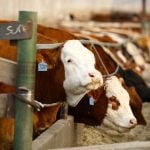
Tag Archives weed control

Early season weed control is key
Spring spraying can be challenging. Look for the right weather and moisture conditions

Managing Group-2 resistant weeds in pulse crops across Western Canada
Cleavers, mustard, kochia and sow thistle are among the weeds getting harder to control, but there are methods, starting with good agronomy

Fall weed management in canola
If you have time for fall weed control in canola fields, make the most of it

Two good reasons for pre-harvest herbicide
Pre-harvest application can give you better weed control and simplify harvest. But know the residue rules

Fighting herbicide resistant weeds with change
Multiple modes of action and stacked seed traits help farmers manage resistance

Mulch-based weed control
Using mulch as a weed control strategy isn’t just for organic growers anymore

The 4Rs of wild oat control
Agronomy tips... from the field

Canola rotations are key
Recommended crop rotations lower inoculum levels and risk of disease

Weed management in soybeans
With high seed prices, farmers will be tempted to lower soybean seeding rates

Avoiding herbicide resistance
Worried weed scientists gather to discuss the future of weed control without new chemistry


